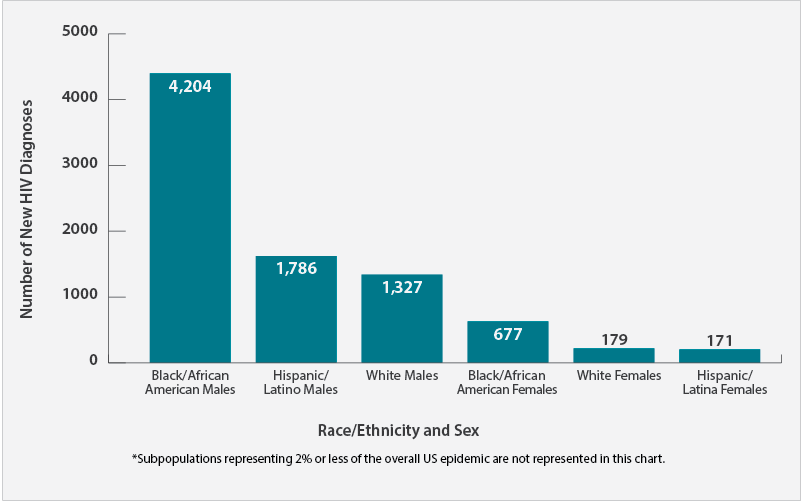HIV Among Youth
Fast Facts
- Youth aged 13 to 24 accounted for more than 1 in 5 new HIV diagnoses in 2015.
- Gay and bisexual males accounted for most new HIV diagnoses among youth in 2015.
- Overall, new HIV infections are declining among young gay and bisexual men.

In 2015, youth aged 13 to 24a accounted for 22% of all new HIV diagnoses in the United States. Most of those new diagnoses among youth (81%) occurred among gay and bisexual males. Young black/African Americanb and Hispanic/Latinoc gay and bisexual males are especially affected; however, we are seeing progress. Estimated annual HIV infections fell 18% among young gay and bisexual males from 2008 to 2014.
Youth with HIV are the least likely out of any age group to be linked to care and have a suppressed viral load (that is, having a very low level of the virus in the body, which helps the person stay healthy and greatly reduces the risk of transmitting HIV to others). Addressing HIV in youth requires that we give young people the information and tools they need to reduce their risk, make healthy decisions, and get treatment and care if needed.
The Numbers
New Infections and Diagnosesd
- Estimated annual HIV infections declined 18% among young gay and bisexual males from 2008 to 2014.
- In 2015, 8,807 youth were diagnosed with HIV in the United States. Eighty percent (7,084) of those diagnoses occurred in persons aged 20 to 24.
- Among youth diagnosed with HIV in 2015, 81% (7,109) were gay or bisexual males. Of newly diagnosed males, 55% (3,888) were black, 24% (1,672) were Hispanic/Latino, and 16% (1,159) were white.
- In 2015, 1,489 youth were diagnosed with AIDS, representing 8% of total AIDS diagnoses that year.
New HIV Diagnoses Among Youth Aged 13-24
in the United States, by Race/Ethnicity and Sex, 2015

Source: CDC. Diagnoses of HIV infection in the United States and dependent areas, 2015. HIV Surveillance Report 2016;27.
Living With HIV and Deaths
- At the end of 2013, an estimated 60,900 youth were living with HIV in the United States. Of these, 51% (31,300) were living with undiagnosed HIV—the highest rate of undiagnosed HIV in any age group.
- Among youth who were diagnosed with HIV in 2014, 68% were linked to care within 1 month—the lowest rate of any age group.e
- Among youth who were diagnosed with HIV in 2012 or earlier, 55% were retained in HIV care and 44% had a suppressed viral load—the lowest rate of viral suppression for any age group.
- In 2014, 117 youth aged 15 to 24 died from HIV.
Prevention Challenges
Inadequate Sex Education. The status of sexual health education varies throughout the United States and is insufficient in many areas according to CDC’s 2014 School Health Profiles. In most states, fewer than half of high schools teach all 16 topics recommended by CDC. Many curricula do not include prevention information for young gay and bisexual men. In addition, sex education is not starting early enough: in no state did more than half of middle schools meet goals set by CDC. Finally, sex education has been declining over time. The percentage of US schools in which students are required to receive instruction on HIV prevention decreased from 64% in 2000 to 41% in 2014, according to the School Health Policies and Practices Study.
Risk behaviors. 2015 data from the Youth Risk Behavior Surveillance System (YRBS), which monitors health risk behaviors that contribute to the leading causes of death and disability among youth, reveal:
- Low rates of testing. Only 10% of high school students have been tested for HIV. Among male students who had sexual contact with other males, only 21% have ever been tested for HIV.
- Substance use. Nationwide, 21% of all students who are currently sexually active (had sexual intercourse during the previous 3 months) and 32% of male students who had sexual contact with other males drank alcohol or used drugs before their most recent sexual intercourse.
- Low rates of condom use. Nationwide, nearly half (43%) of all sexually active high school students and 49% of male students who had sexual contact with other males did not use a condom the last time they had sexual intercourse.
- Number of partners. One-third (33%) of male students who had sexual contact with other males reported sexual intercourse with 4 or more persons during their life, compared to 12% of all students who had ever had sexual contact.
High rates of sexually transmitted diseases (STDs). Some of the highest STD rates are among youth aged 20 to 24, especially youth of color. The presence of another STD greatly increases the likelihood that a person exposed to HIV will become infected.
Stigma around HIV. In a 2012 Kaiser Family Foundation survey, 84% of youth aged 15 to 24 said there is stigma around HIV in the United States. This could mean that they are not comfortable discussing their status with others and talking with their partners about ways to protect themselves from HIV and other STDs. For gay and bisexual youth who are just beginning to explore their sexuality, homophobia can pose obstacles to utilizing HIV prevention services, testing, and treatment.
Feelings of isolation. Gay and bisexual high school students may engage in risky sexual behaviors and substance abuse because they feel isolated and lack support. They are more likely than heterosexual youth to experience bullying and other forms of violence, which also can lead to mental distress and engagement in risk behaviors that are associated with getting HIV. In the 2015 YRBS, 34% of gay, lesbian, or bisexual students reported being bullied in the previous 12 months, compared to 20% of all students.
What CDC Is Doing
CDC uses a multifaceted approach to meet the goals of the National HIV/AIDS Strategy:
- CDC funds state and local health departments to develop and implement HIV prevention programs in the communities most affected by HIV.
- CDC awarded $11 million per year for 5 years, beginning in 2011, to community-based organizations to provide HIV testing to young gay and bisexual men and young transgender persons of color, with the goals of identifying previously unrecognized HIV infections and linking those who have HIV to care and prevention services. A new funding opportunity focusing on this population will begin in 2017 and continue for 5 years, depending on the availability of funds.
- CDC’s Division of Adolescent and School Health collects and reports data on youth health risk behaviors and funds state and local education agencies and nongovernmental organizations to help schools deliver health education emphasizing HIV/STD prevention, increase teen access to health services, and establish safe and supportive environments for students. For example:
- Advocates for Youth assists state and local education agencies with implementing programs to meet the HIV/STD prevention needs of young gay and bisexual men.
- The National Coalition of STD Directors works with state education agencies, and Cicatelli Associates Inc. (CAI) works with local education agencies to increase adolescent access to preventive health services.
- The American Psychological Association works with state education agencies, and the Gay-Straight Alliance Network works with local education agencies to establish safe and supportive learning environments for students and staff.
- CDC’s Act Against AIDS initiative focuses on raising awareness about HIV, fighting stigma, and reducing the risk of HIV infection among at-risk populations through campaigns such as Doing It, which motivates individuals to get tested for HIV and know their status.
a Persons aged 13-24 are referred to as youth or young in this fact sheet.
b Referred to as black in this fact sheet.
c Hispanics/Latinos can be of any race.
dHIV and AIDS diagnoses indicate when a person is diagnosed with HIV or AIDS, not when the person was infected. Estimated annual HIV infections are the estimated number of new infections (HIV incidence) that occurred in a particular year, regardless of when those infections were diagnosed.
e In 32 states and the District of Columbia (the areas with complete lab reporting by December 2015).
Bibliography
- CDC. Diagnoses of HIV infection in the United States and dependent areas, 2015. HIV Surveillance Report 2016:27. Accessed January 27, 2017.
- CDC. Monitoring selected national HIV prevention and care objectives by using HIV surveillance data-United States and 6 dependent areas—2014. HIV Surveillance Supplemental Report 2016:21(4). Accessed January 27, 2017.
- Kaiser Family Foundation. National survey of teens and young adults on HIV/AIDS. November 1, 2012. Accessed January 27, 2017.
- CDC. Vital Signs: HIV infection, testing, and risk behaviors among youths — United States. MMWR 2012;61(No. SS-4). Accessed January 27, 2017.
- CDC. Youth risk behavior surveillance — United States, 2015. MMWR 2016;65(No. SS-6). Accessed January 27, 2017.
- CDC. Sexually transmitted disease surveillance, 2015. Accessed January 27, 2017.
- Committee on Pediatric AIDS. Policy statement: reducing the risk of HIV infection associated with illicit drug use. Pediatrics 2006;117(2):566-71. Accessed January 27, 2017.
- CDC. HIV and young men who have sex with men. June 2012. Accessed January 27, 2017.
- Just the Facts Coalition. Just the facts about sexual orientation and youth: a primer for principals, educators, and school personnel. Washington, DC: American Psychological Association; 2008. Accessed January 27, 2017.
- CDC. School Health Policies and Practices Study.
- SAMHSA. Results from the 2013 National Survey on Drug Use and Health: Summary of National Findings. September 2014. Accessed January 27, 2017.
- CDC. Sexual identity, sex of sexual contacts, and health-risk behaviors among students in grades 9-12–youth risk behavior surveillance, selected sites, United States, 2001-2009. MMWR 2011;60(7): 1:33. Accessed January 27, 2017.
- Singh S, Song R, Johnson AS, McCray E, Hall I. HIV incidence, prevalence, and undiagnosed infections in men who have sex with men. Talk presented at: Conference on Retroviruses and Opportunistic Infections; February 13-16, 2017; Seattle, WA. http://www.croiconference.org/sessions/hiv-incidence-prevalence-and-undiagnosed-infections-men-who-have-sex-men. Accessed March 9, 2017.
Additional Resources
General Resources
- CDC-INFO 1-800-CDC-INFO (232-4636)
- CDC HIV Website
- CDC Act Against AIDS Campaign
- CDC HIV Risk Reduction Tool (BETA)
- Page last reviewed: April 7, 2017
- Page last updated: September 21, 2017
- Content source: Division of HIV/AIDS Prevention, National Center for HIV/AIDS, Viral Hepatitis, STD, and TB Prevention, Centers for Disease Control and Prevention


 ShareCompartir
ShareCompartir